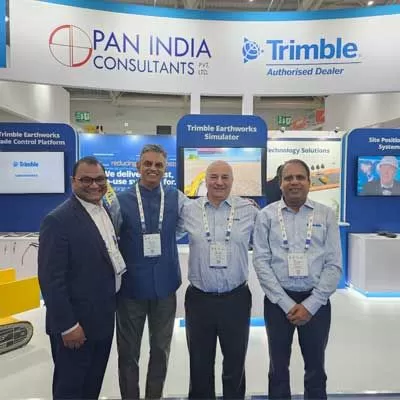- Home
- Infrastructure Urban
- ECONOMY & POLICY
- A Savage Quarter
A Savage Quarter
The Indian construction sector has had a savage September quarter - one of the worst in recent times. Financial results released till the last week of November indicate an overall gloom in the industry. Of the 53 engineering, procurement and construction (EPC) companies under review, 17 reported a decline in their topline, while more than half (27 companies) reported negative bottomline growth during the quarter ended September 2011. Thus, one out of every two companies posted a loss in the said quarter.
Aggregate revenue grew by over 15 per cent year-on-year, while net profits inched up just 5 per cent. This scenario, in broad comparison, is better than the overall results of listed companies. Aggregate results of 1,360 companies show their net profits sliding 9.2 per cent in the quarter as against the topline growth of 23.9 per cent. This reflects a slowdown in corporate performance. Analysts estimate that profit may fall by more than 17 per cent once the remaining 3,000 companies announce their results.
And, this would be the steepest fall in corporate profits since the global liquidity crisis of 2008-09. During the first two quarters of 2010-11, the performance of EPCs was flat with topline growing 15 per cent and bottomline 6 per cent.
The main blow has come from two important cost variables: interest and raw materials. While interest payout increased 38 per cent - the highest rise amongst all cost variables in the September quarter - raw material costs have increased 22 per cent. Both these variables have been the outcome of stubborn high inflation. Monetary policies have been hiking interest rates to rein in inflation, and material costs are rising owing to an across-the-board increase in commodity prices, domestic as well as global.
Size matters
The quarterly results have thrown up an interesting trend. This quarter, medium-size companies (with annual revenue between Rs 1,000 crore and Rs 2,000 crore) have performed much better both in topline and bottomline growth, while small-size companies (with revenue less than Rs 1,000 crore) once again failed to gather momentum. Larger companies had a modest quarter but took a hit on profitability (see table alongside). The advantage for medium-size companies that led to their robust bottomline growth was a leaner interest expense. The past five quarters have seen their interest expense decline year-on-year on three occasions, and the rise on two other occasions was not more than 4 per cent. In similar comparison, the interest expense of small-size companies has galloped close to 50 per cent in the second quarter, almost twice the increase seen in the first. This implies that small-size companies are unable to raise debt at a competitive rate of interest.
Dwindling interest cover ratio
Rising interest rates have been pushing many construction companies to the brink, making it difficult for them to service the interest costs on their borrowings. An analysis of the latest results for the 53 companies reveals that 24 companies - nearly half of the total - now have an interest cover of 1.5 times or less. Interest coverage ratio determines how easily a company can pay interest on its outstanding debt. The lower the ratio, the more the company is burdened by debt expense. When a company's interest coverage ratio is 1.5 or lower, its ability to meet interest expenses is questionable. A ratio below 1 indicates that the company is not generating sufficient revenue to satisfy interest expenses.
The interest coverage ratio is calculated by dividing a company's earnings before interest and taxes (EBIT) during the quarter by the company's interest expenses of the same quarter.
In the preceding June quarter, the number was 19 companies. Almost 40 companies have seen a slippage in their interest cover ratio in a span of just three months. This is even worse than
the June quarter when 34 companies were seen slipping in their ratio. Overall, the interest cover for the 53 companies came down from 2.85 times to 2.43 times between June and September 2011, while the sales growth has remained flat in both quarters.
Here, construction companies incurring heavy debts on their balance-sheets faced a double whammy:
- Relentless raw material price increases, not passed on fully to consumers, have dented operating profit margins.
- Interest rates have edged up further. As a result, financing costs have ballooned, thus reducing the profit available to service loans.
Only six companies were in a very comfortable zone in terms of interest coverage; Man Infraconstruction, KNR Constructions, RPP Infra Projects, Petron Engineering Construction, Larsen & Toubro (L&T) and Rajoo Engineers had a ratio above 5. They were also in the same zone in all the past 10 quarters.
The worry of loans servicing is not only hurting construction companies. Recently, the Reserve Bank of India (RBI) had raised concern over the rising bad loans of Indian banks, especially for advances given to infrastructure, real estate and retail companies. It also noted that banks are likely to be more affected by such loans in a high-interest scenario unless they take 'due care' of such risky assets. This implies that banks will be extra cautious when it comes to lending to construction companies.
The prospects
The bountiful rains in the 2011 southwest monsoon have apparently not translated into a boom in India's economic growth. Many experts have revised their projections of GDP growth to below 8 per cent. The RBI has lowered its growth estimates to 7.6 per cent from 8 per cent for the current fiscal. Similarly, economic think-tank, Centre for Monitoring Indian Economy (CMIE) has also lowered its estimates to 7.8 per cent from 8 per cent earlier. This does not auger well for the construction industry as prospects appear bleak. While high interest rates will remain sticky for the rest of the year, inflationary pressure will be hard to ward off. The recent life-low of the rupee against the US dollar will exert pressure on inflation as imports will be costlier, particularly that of crude oil. Further, availability of funds will be a major constraint. Bank lending to the infrastructure sector went up to Rs 5.6 trillion by September-end from Rs 4.7 trillion a year ago. Pushing this up further will be difficult given that many borrowers have reached their internal limits set for such loans. Besides, an increasing asset-liability mismatch is also affecting the ability of banks to fund long-term infrastructure projects.
Nevertheless, the silver lining could be the government's endeavour to adopt better supply-side measures to tackle inflation and its commitment to develop infrastructure that
can provide sustained economic growth in the future. The current development could well be
an aberration.
To share your views on the above article, write in at feedback@ASAPPmedia.com
The quarter ending September 2011, which also happened to be lean for construction activity, witnessed modest topline growth, but net profit took a severe beating amidst rising costs and hard-to-come new projects, according to Nitin Madkaikar, Economist, FIRST Infocentre.The Indian construction sector has had a savage September quarter - one of the worst in recent times. Financial results released till the last week of November indicate an overall gloom in the industry. Of the 53 engineering, procurement and construction (EPC) companies under review, 17 reported a decline in their topline, while more than half (27 companies) reported negative bottomline growth during the quarter ended September 2011. Thus, one out of every two companies posted a loss in the said quarter.Aggregate revenue grew by over 15 per cent year-on-year, while net profits inched up just 5 per cent. This scenario, in broad comparison, is better than the overall results of listed companies. Aggregate results of 1,360 companies show their net profits sliding 9.2 per cent in the quarter as against the topline growth of 23.9 per cent. This reflects a slowdown in corporate performance. Analysts estimate that profit may fall by more than 17 per cent once the remaining 3,000 companies announce their results.And, this would be the steepest fall in corporate profits since the global liquidity crisis of 2008-09. During the first two quarters of 2010-11, the performance of EPCs was flat with topline growing 15 per cent and bottomline 6 per cent.The main blow has come from two important cost variables: interest and raw materials. While interest payout increased 38 per cent - the highest rise amongst all cost variables in the September quarter - raw material costs have increased 22 per cent. Both these variables have been the outcome of stubborn high inflation. Monetary policies have been hiking interest rates to rein in inflation, and material costs are rising owing to an across-the-board increase in commodity prices, domestic as well as global.Size mattersThe quarterly results have thrown up an interesting trend. This quarter, medium-size companies (with annual revenue between Rs 1,000 crore and Rs 2,000 crore) have performed much better both in topline and bottomline growth, while small-size companies (with revenue less than Rs 1,000 crore) once again failed to gather momentum. Larger companies had a modest quarter but took a hit on profitability (see table alongside). The advantage for medium-size companies that led to their robust bottomline growth was a leaner interest expense. The past five quarters have seen their interest expense decline year-on-year on three occasions, and the rise on two other occasions was not more than 4 per cent. In similar comparison, the interest expense of small-size companies has galloped close to 50 per cent in the second quarter, almost twice the increase seen in the first. This implies that small-size companies are unable to raise debt at a competitive rate of interest.Dwindling interest cover ratioRising interest rates have been pushing many construction companies to the brink, making it difficult for them to service the interest costs on their borrowings. An analysis of the latest results for the 53 companies reveals that 24 companies - nearly half of the total - now have an interest cover of 1.5 times or less. Interest coverage ratio determines how easily a company can pay interest on its outstanding debt. The lower the ratio, the more the company is burdened by debt expense. When a company's interest coverage ratio is 1.5 or lower, its ability to meet interest expenses is questionable. A ratio below 1 indicates that the company is not generating sufficient revenue to satisfy interest expenses.The interest coverage ratio is calculated by dividing a company's earnings before interest and taxes (EBIT) during the quarter by the company's interest expenses of the same quarter. In the preceding June quarter, the number was 19 companies. Almost 40 companies have seen a slippage in their interest cover ratio in a span of just three months. This is even worse than the June quarter when 34 companies were seen slipping in their ratio. Overall, the interest cover for the 53 companies came down from 2.85 times to 2.43 times between June and September 2011, while the sales growth has remained flat in both quarters.Here, construction companies incurring heavy debts on their balance-sheets faced a double whammy:Relentless raw material price increases, not passed on fully to consumers, have dented operating profit margins. Interest rates have edged up further. As a result, financing costs have ballooned, thus reducing the profit available to service loans. Going by the criteria, companies like Vascon Engineers, Ahluwalia Contracts (India), Hindustan Construction Company (HCC), Punj Lloyd, Consolidated Construction Consortium, IL&FS Engineering & Construction Company, Artson Engineering, Welspun Projects and Coromandel Engineering Company were unable to generate sufficient revenues to satisfy interest expenses during the quarter. The slippages in the interest cover ratio have also declined sharply and sequentially, except for Vascon, which managed to lift its ratio closer to 1.Only six companies were in a very comfortable zone in terms of interest coverage; Man Infraconstruction, KNR Constructions, RPP Infra Projects, Petron Engineering Construction, Larsen & Toubro (L&T) and Rajoo Engineers had a ratio above 5. They were also in the same zone in all the past 10 quarters.The worry of loans servicing is not only hurting construction companies. Recently, the Reserve Bank of India (RBI) had raised concern over the rising bad loans of Indian banks, especially for advances given to infrastructure, real estate and retail companies. It also noted that banks are likely to be more affected by such loans in a high-interest scenario unless they take 'due care' of such risky assets. This implies that banks will be extra cautious when it comes to lending to construction companies.The prospectsThe bountiful rains in the 2011 southwest monsoon have apparently not translated into a boom in India's economic growth. Many experts have revised their projections of GDP growth to below 8 per cent. The RBI has lowered its growth estimates to 7.6 per cent from 8 per cent for the current fiscal. Similarly, economic think-tank, Centre for Monitoring Indian Economy (CMIE) has also lowered its estimates to 7.8 per cent from 8 per cent earlier. This does not auger well for the construction industry as prospects appear bleak. While high interest rates will remain sticky for the rest of the year, inflationary pressure will be hard to ward off. The recent life-low of the rupee against the US dollar will exert pressure on inflation as imports will be costlier, particularly that of crude oil. Further, availability of funds will be a major constraint. Bank lending to the infrastructure sector went up to Rs 5.6 trillion by September-end from Rs 4.7 trillion a year ago. Pushing this up further will be difficult given that many borrowers have reached their internal limits set for such loans. Besides, an increasing asset-liability mismatch is also affecting the ability of banks to fund long-term infrastructure projects.Nevertheless, the silver lining could be the government's endeavour to adopt better supply-side measures to tackle inflation and its commitment to develop infrastructure that can provide sustained economic growth in the future. The current development could well be an aberration.To share your views on the above article, write in at feedback@ASAPPmedia.com





















